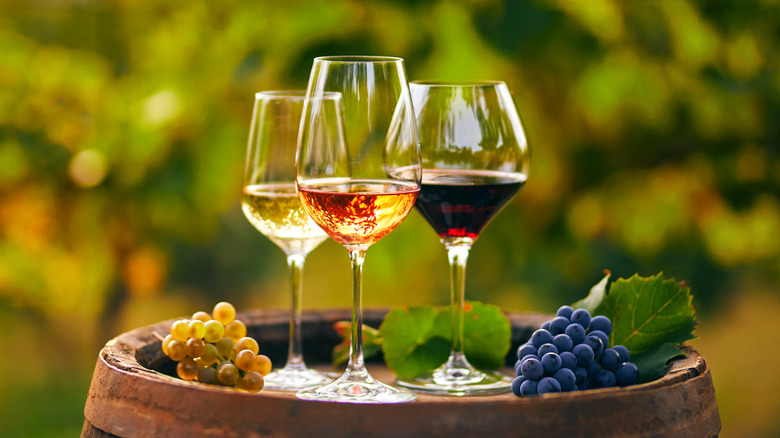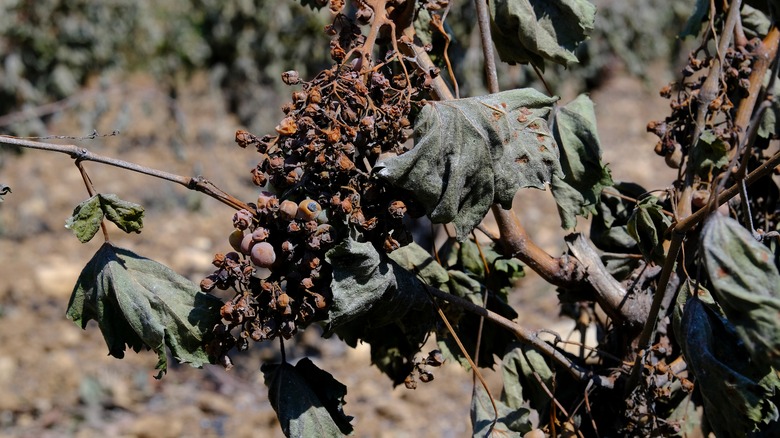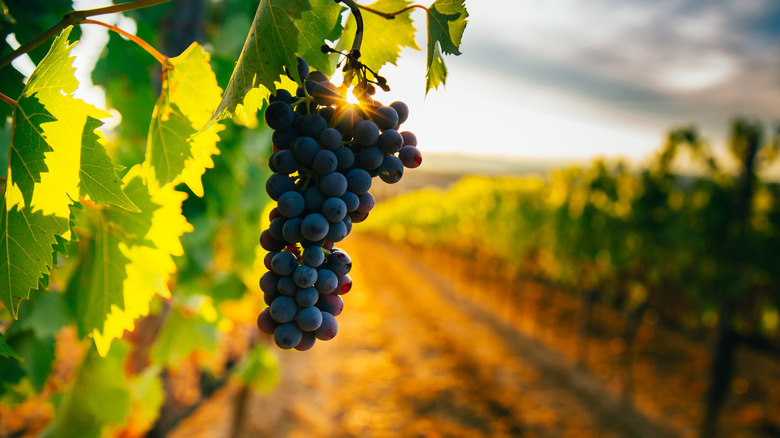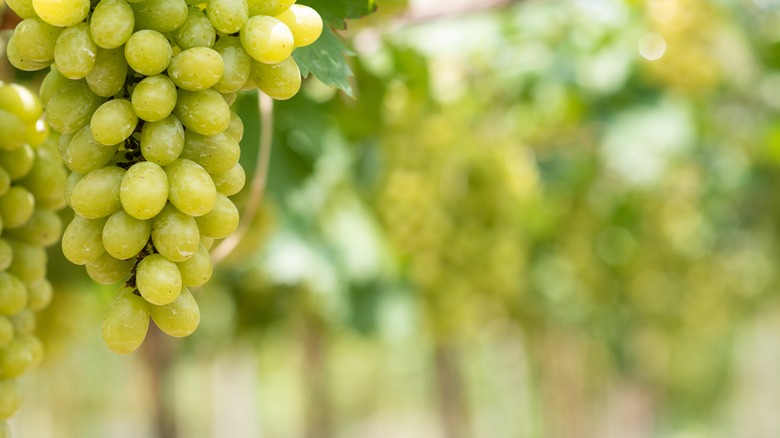How Climate Change And Hybrid Grapes Are Impacting The Wine Industry
Climate change brings a higher degree of unpredictability when it comes to weather patterns. NOAA states that weather is a short-term state of atmospheric conditions on a given day or two in a specific region, while climate is weather over a longer period of years. The climate of the planet is measurably warmer, and, as such, experiencing violent storms, deep freezes, damaging hail, increased wind, and more frequent wildfires. But it also isn't changing unilaterally across the globe. Some places are warming more quickly than others. According to the Center for Science Education, droughts, flooding, hurricanes, and other climate disasters are increasing in frequency, intensity, and duration.
Perhaps nowhere are the effects of climate change more noticeable than in the glass of wine you enjoy with your evening meal. While some wine regions are celebrating these changes, projections indicate that they will be short-lived as temperatures continue to rise, according to Dr. Lee Hannah and the National Academy of Sciences. Hannah suggests that nearly all wine regions will be negatively impacted by climate change by the year 2050.
Grapes under seige
As weather patterns become more volatile due to changes in climate, grape vines are subjected to increased heat, drought, sunburn, fires, increases in disease and pests, unpredictable frost, damaging hail storms, and unexpected freezes. Grape vines are delicate and exhibit signs of stress readily when exposed to climate fluctuations. Vines prefer a stable growing environment with few surprises. Some grape varietals are more adaptable than others (via Knowable).
The Wine Society notes that climate change is altering the quality of wine with vintages improving in some regions and suffering in others. Yet, weather unpredictability is the primary issue wine producers are concerned with. Once reliable weather patterns made for easy planning in vineyards and wineries. Now, winemakers fear for the future because even under the best circumstances, erratic weather isn't good for grape vines in any wine region.
Many traditional wine regions like Tuscany in Italy, the Margaret River in Australia, Napa in California, and Burgundy in France, are becoming too hot for grapes to thrive, resulting in sunburned grapes, excessive sugars, and wines with cooked or baked flavors and spiking alcohol levels.
The New York Times reports that emerging regions British Columbia, Canada, England, Scandinavia, China, and the United States, are benefitting from temperature increases that lengthen growing seasons. Formerly, grapes struggled to ripen in these areas, but climate change is allowing for even grape ripening with higher sugar content and early phenolic ripeness resulting in balanced and flavorful wines.
Riper, jammier, stronger wine
Knowable Magazine reported that grapes contain three components necessary for balanced wines: sugar, acid, and molecules responsible for flavor and color. When these components are in harmony with one another, the grapes produce lithe and heady wines with mouthwatering acidity or velvety tannins. As climate changes, the balance of these components changes within the grape, therefore, altering the quality of the finished wine. Wine flavors are becoming riper and jammier with undesirable notes of baked, stewed, or cooked fruit. Sweet tropical fruit notes are replacing crisp stone fruit and tangy berries.
According to The Wine Society, wine is increasing in alcohol levels as grapes ripen more quickly and fully in hot seasons, increasing the sugar content. When fermented, high sugar levels correspond to higher alcohol levels.
According to Decanter, "Table wines prior to the 1980s varied between 11% and 12.5%; few crested 13%. (The 1959 vintage in Bordeaux, for example, was a dry and hot one, yet the Château Latour of that vintage measures just 11.6%, according to Latour's president, Frédéric Engerer.) Nowadays, any table wine less than 13% is a rarity."
Hybrid and indigenous grapes
Classic wine regions have produced signature wines from specific grapes for centuries. Bordeaux is legendary for its Cabernet Sauvignon and Merlot blends. Burgundy is recognized for Pinot Noir and Chardonnay. Tuscany is identified with Sangiovese, and Tempranillo is the heart of Rioja. Unique regional wine styles are becoming indistinguishable as wine becomes homogenized in flavor and texture. Decanter reveals that in 2019, Bordeaux approved seven heat and drought-resistant grape varietals in efforts to adapt to their changing climate. Champagne producers are softening their viticulture rules, as are many storied regions across the wine world. Italian and Spanish winemakers are seeking to revive their heritage grapes, sources say.
If Lee Hannah's predictions are valid, wine regions must adapt to survive. Winemakers scramble for solutions to mitigate climate change's effects on their cash crop. Many grape growers and wineries are beginning to realize that popular grape varietals like Chardonnay, Pinot Noir, and Cabernet Sauvignon, are no longer viable choices. Civil Eats reports that winemakers are seeking alternate varietals, hearty indigenous grapes and hybrids that have been created for resilience against climatic forces and disease.
Indigenous and hybrid grapes exude different aroma and flavor profiles than most consumers are used to. Winemakers need to champion these non-traditional grapes in order to survive the threats climate change brings. Consumers will need to embrace new wine styles and different wine regions just as winemakers will, but, isn't that exciting?



